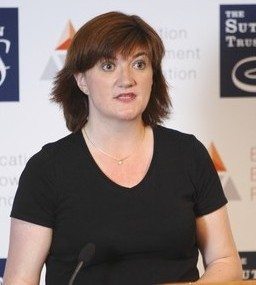Opinion
Summit Rapporteur Matt Rodda reports from today’s Sutton Trust/EEF pupil premium summit.

Keynote speech: Secretary of State, Rt Hon Nicky Morgan MP
Sutton Trust/Education Endowment Foundation
Pupil Premium Summit
Wednesday 1st July 2015
Photo: Zute Lightfoot
Delegates attending the Sutton Trust and the EEF’s Pupil Premium Summit today who came by tube will have heard the familiar phrase “mind the gap” which is so often announced at underground stations.
The summit addressed the equally well known attainment gap that the pupil premium has sought to narrow, with contributions reflecting on the nature of the gap, how best to measure it as well as identifying progress in closing the gap.
Education Secretary Nicky Morgan opened the summit by stressing the Government’s commitment to the Pupil Premium.
Mrs Morgan, said it was right that there was targeted funding and she praised the work schools were doing with teachers working hard to make best use of the premium but said “too many young people were still falling behind”.
She said the challenge now was for more effective dissemination of best practice in using the premium, pointing out that this was identified as a key priority in a National Audit Office report on the Pupil Premium which was published yesterday (Tuesday).
The Education Secretary also reflected on the broader thrust of education policy. She hoped there would be widespread agreement that all children should be able to achieve their full potential. She stressed that the Government wanted to tackle the “soft bigotry” of low expectations such as offering every pupil to study Ebacc subjects.
Mrs Morgan’s reflections touched on various aspects of the discussion at the summit, which included an essay published by Dr Rebecca Allen, Director of Education Datalab, which pointed out that the attainment gap was not closing on some measures although it was narrowing on others.
The headline figures showed the gap between the proportion of pupil premium and non pupil premium pupils gaining five good GCSEs including English and maths hardly changing. (This was a gap of 26.4 and 26.2 per cent in 2011 and 2014).
However, she said that these numbers do not tell the whole story as they are dependent on students gaining a C or above in English and maths and many of the pupils concerned were progressing but sadly were not always achieving a C in these two subjects.
This is made even harder for many schools as a proportion of pupil premium students are very low attaining.
However, if the new Attainment 8 accountability measure was used it would show that the gap was narrowing quite dramatically because the new measure monitors the grades of pupils across eight subjects.
Dr Allen also pointed out that there was considerable variation between pupils who receive the premium because of the wide range of students who attract pupil premium funding.
The diversity of the group was also commented on by the Sutton Trust in its recommendations, which called not only for the premium to continue but crucially for it to be linked to disadvantage, not just prior attainment.
“Giving disadvantaged young people the best start in life is a vital national endeavour”, as Peter Lampl said, in his foreword to the summit papers. He described this as a measure which would “pay dividends in providing a more skilled workforce and a stronger social fabric for the future.”
Sir Kevan Collins, Chief Executive of the Education Endowment Foundation, called for a system which made best use of evidence and autonomy “where every child, of any background, can fulfil their potential”.
The Sutton Trust’s Dr Lee Elliot Major and Professor Steve Higgins, of Durham University, emphasised the importance of money being spent effectively with reference to the pupil premium toolkit.
Pupil Premium Champion, Sir John Dunford, discussed the importance of gaining the profession’s support and encouraging a sense of moral purpose to deliver sustained improvement.
Meanwhile, the Chief Inspector, Sir Michael Wilshaw, emphasised the importance of good leadership in improving the system. He also made a robust defence of Ofsted and the need for inspection to help drive school improvement.
Taken together the contributions made for some thought provoking commentary on the Pupil Premium and its relative success and potential future progress in narrowing the attainment gap.
While some of the views may have differed there was no doubt that reducing the attainment gap remains a vital national endeavour.